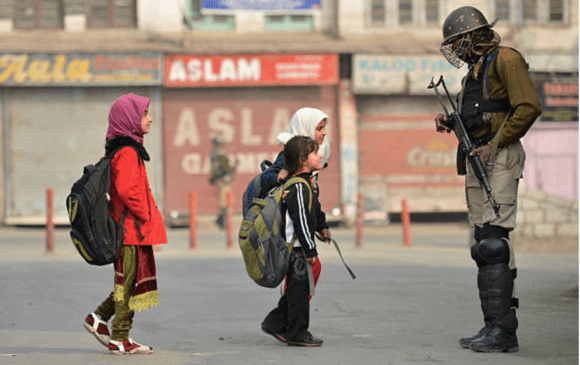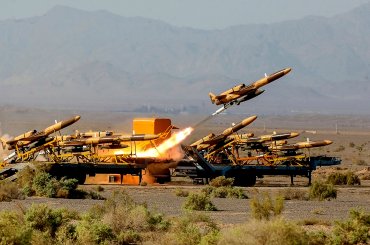As Israelis prepare for a snap election in September, politicians are once again calling to annex the West Bank, a campaign promise by Prime Minister Benjamin Netanyahu last April in a bid to rally support from the right. The talk of extending the application of Israeli law runs eerily close to India’s annexation of Jammu and Kashmir last week when it revoked a constitutional arrangement that had granted autonomy to the state.
Beyond the Israel and India comparison, parallels drawn between Kashmir and Palestine have intensified in recent years. Much has been written about these two places and on why they can or cannot be compared, or how Kashmir is going the Palestinian way. While the political histories of both disputes are different, strong overlaps exist as they were both midwifed by the waning British Empire in 1947, are governed by United Nations resolutions which have resulted in their internationalization, and are unresolved geopolitical disputes. Resistance movements in both Palestine and Kashmir constantly battle the label of “Islamic terrorism,” even though they are nationalist movements for freedom. Much of this resistance also comprises of poets, artists, novelists, lawyers, scholars, and human rights defenders. One important parallel is disproportionate and acute political suffering due to the scale of human rights violations, and the everyday violence of militarized occupation that Palestinians and Kashmiris have had to endure. On August 14, a four person fact-finding mission to Kashmir reported that Indian forces are arresting young children, in danger of disappearance, and women are being molested. Kavita Krishnan, a member of the Community Party, India (Marxist-Leninist) has stated: “Frankly it looks like occupied Iraq or occupied Palestine.”
These parallels between India and Israel have a basis in their now close kinship based on a billion-dollar military alliance. According to the SIPRI Institute which tracks arms transfers, India is Israel’s biggest arms importer, cornering 46 percent of Israel’s arms trade. While India’s largest arms exporter is Russia, Israel is its second largest, followed by France and the U.S. Indian and Israeli companies, like Adani Global and Herman Elbit are collaborating on the manufacture of drones for the global market also for use in Palestine and Kashmir, and their governments exchange counter-insurgency techniques. Yet, what makes for a more intimate relationship between the two countries is the combination of this weapons alliance with a brand of fascist religious nationalism.

India began its existence as a democratic republic in a violent cauldron of communal politics, and partition in 1947. These events had long-lasting consequences for Kashmiris. Maharajah Hari Singh, the ruler of the independent princely state of Jammu and Kashmir, was reluctant to accede either to Pakistan or India. Kashmir had been sold to his ancestor Gulab Singh by the British East India Company in 1846. The Dogras was despotic rulers. Kashmiris were already engaged in a freedom struggle against the Dogras before the fateful events of 1947. Recent scholarship by Australian historian Christopher Snedden disputes the conventional narrative of Pakistani invasion, and Indian troops landing as Kashmir’s saviors in 1947, compelling the Maharaja to accede to India. The hurried and contested accession to India took place under the circumstances of Kashmiri rebellion. Snedden states that it is Kashmiris themselves who initiated the dispute for the cause of their freedom.
Following the first India-Pakistan war of 1947-1948, a UN Security Council resolution recommended measures to India and Pakistan for a ceasefire and to create proper conditions for a free and impartial plebiscite for Kashmiris.
India’s first Prime Minister Jawaharlal Nehru had taken the issue to the UN, but betrayed the promise of a free and fair plebiscite that had been a part and parcel of the accession treaty and affirmed by Lord Mountbatten. While there have been wars and a bilateral agreement between India and Pakistan over Kashmir, UN Security Council resolutions from 1948 to 1957 are still applicable to Kashmir.
UN Secretary-General António Guterres has reiterated Kashmir’s international status in his response to India’s attempt to turn Kashmir into a domestic affair. Following the government of India’s betrayal, constitutional occupation and political repression in Kashmir, military occupation from the 1990s on, we can say that for the post-independence, (post) colonial state of India, Kashmir has been a colonial project since 1947.
In 1947 during the partition Hindu mobs killed between 200,000 to 500,000 Muslim men, women and children, and about 200,000 people went missing. Evidence shows that the Hindu monarch oversaw the pogrom; many fled to Azad Kashmir and Pakistan. The large-scale killings and displacement of Muslims caused significant demographic changes, which were most likely engineered to sway Kashmir towards India if the plebiscite was ever held. The plebiscite was never held.
Adopted by the Indian Constitution in 1954, Article 370 was India’s replacement for that betrayed promise of a plebiscite. For the last 65 years, it has been an alibi for India’s democratic and constitutional relationship with Kashmir. It was the basis for Kashmir’s accession, and in return, Kashmir’s autonomy. India controlled defense, communications, foreign affairs and finance, and Kashmir was meant to enjoy a degree of self-governance, including a state constitution enshrining protections that ensured Kashmiri land ownership. Deeming the removal of Article 370 unconstitutional and illegal, constitutional expert A.G. Noorani has argued that Article 370 had already lost much of its strength due to continual Presidential orders. Autonomy had been hollowed out, and local Kashmiri governments were effectively puppet regimes. This phenomenon has been called “occupational constitutionalism” by socio-legal scholars Haley Duschinski and Shrimoyee Ghosh. It is in this sense that Kashmir has been a steady colonial project.
On August 5 when Amit Shah, India’s Minister for Home Affairs, announced the effective revocation of Article 370, it also invalidated Article 35A. This 1927 Permanent Residency Act stipulates that only Kashmiris can possess right to franchise, and property. The abrogation of Article 35A and the simultaneous bifurcation of the state of Jammu and Kashmir into two union territories possibly spells the inauguration of Indian settler-colonialism in Kashmir. Kashmiris rightly fear that the Indian settlers can now own land and commercially exploit the resources of Kashmir on an unprecedented scale.
A scholar of South Asian history, Hafsa Kanjwal has argued in the Washington Post that Indians investing, buying land and moving into Kashmir may result in changes to the demography, an ethnic cleansing in this Muslim-majority state. In a region that is already feeling the effects of climate change through rising temperatures through a melting snow line and floods in recent years, this is a catastrophe for both Kashmiris and the ecology of the region. Indian Prime Minister Narendra Modi’s Kashmir policy is thus an attempt to transform a colonial occupation into a Hindutva, or Hindu nationalist, settler-colonial imperative. The overt arms trade between Israel and India, long covert even in India’s Congress secular days, now represents the logic of a fascist, capitalist, Islamophobic geocolonial formation invested in dispossessing and brutalizing Palestinians and Kashmiris.
There are, of course, differences in the histories of India and Israel. Israel was created through the process of settler-colonialism even before its West Bank policy. Israeli settlers began arriving from Europe and built the first settlements or Kibbutzim by 1909. Later the British Mandate of Palestine aided settlers. And by 1947, UN resolution 181 called for the partition of Palestine. Terrorist militias like Irgun and Haganah were integral to Zionist leaders for the expulsion of Palestinian Muslims and Christians and dispossession of their lands between 1947 and 1949, during the war that bookended the creation of the state of Israel. At the time of ceasefire, 78 percent of historic Palestine had become Israel. During the 1967 war with Arab countries, Israel occupied East Jerusalem, the West Bank and the Gaza Strip. UN Resolution 242 called for Israeli withdrawal from the occupied territory.
Kashmiri Solidarity with Palestine
Even though these differences exist between the histories of India and Israel, Kashmiris have expressed solidarity with Palestine because of a sense of resonance with their own experiences. From protests against Israeli occupation of the Al-Aqsa mosque in the 1960s to 2018, when the Palestinians were protesting the moving of the U.S. embassy from Tel Aviv to Jerusalem, Kashmiris have held hundreds of rallies in solidarity. In July 2014, when Kashmiris protested against the Israeli bombing of Gaza, teenager Suhail Ahmed Shah was killed when the Indian forces fired upon the crowd. Invoking freedom for Palestine in the prayers and protests in Kashmir is part of the usual repertoire in Kashmir.
The reflection of Kashmiri solidarity with Palestine is also present in the street graffiti against the Indian rule. Between slogans like “Go India Go Back,” “We want Freedom” one finds “Free Palestine” and “Save Gaza.” The sight of street fighter Kashmiri boys are reminiscent of Palestinian youth throwing rocks at the Israeli soldiers. The similarity in the images makes for news and social media errors where Kashmiri stone-pelters are mistaken for Palestinian ones. Images apart, the word Intifada invokes a strong resonance between the two regions. It was after 2008 that the term Intifada became a commonplace description of Kashmiri struggle in India and Pakistan.
While effective United Nations interventions are needed for Kashmiris and Palestinians, their resistance against these settler/(post) colonial projects continue. Despite the complete lockdown, Kashmiris, as always, are resisting the brutality of the Indian state. Today, 72 years later since India has expressed its will to wear Kashmir as its crown by annexing it, Kashmiris are unyielding and invoke their right to self-determination and sovereignty. Many Kashmiris on social media have been citing Palestinian spoken word poet, Rafeef Ziadeh to respond to the Indian colonialism: “We Teach Life Sir!” Omar Baddar has argued that the Palestinian spirit of resistance will never be broken. Kashmir’s poet Agha Shahid Ali echoes this resistance and resolve when he promises: “We shall meet again, in Srinagar, by the gates of the Villa of Peace, our hands blossoming into fists, till the soldiers return the keys.”



From : Partition Poems: In Kashmir writing under occupation
“i returned home to broken gutters
spilling onto doorsteps,
bullet-casings, old bones
she had kept the roses
from the garden gutted by grenades,
winter had razed the rest
she never bid him goodbye,
her eyes red from the teargas,
in Kashmir
lovers are suspected of seeking Azadi”
Ather Zia